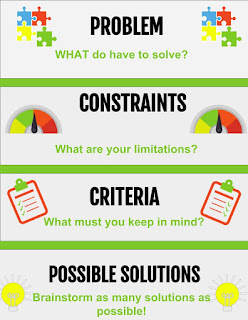As an advocate and enthusiast of STEM Design, I truly embraced the challenge OF the challenge of using Experimental Design (also known as Engineering Design) for instruction. Not knowing EXACTLY what I was doing when I reached this standard for my sixth graders:
MS-PS1-6 Undertake a design project to construct, test and modify a device that either releases or absorbs thermal energy by chemical processes
I started from scratch; researching Experimental Design expectations, exploring what Bozeman Science had to say on the topic, and eventually establishing my own guide for students to participate in Experimental Design.
The infographic above basically establishes the elements that need to be included in any engineering (experimental) design project.
For my students, I broke this down into more manageable steps and began with a SMALL challenge...the candle, thumbtack and match challenge. My goal? To get them to be able to IDENTIFY THE PROBLEM, ESTABLISH CONSTRAINTS and DETERMINE CRITERIA and to develop POSSIBLE SOLUTIONS.
As I introduced my students to this process of Experimental Design I needed them to be able to understand CONSTRAINTS and CRITERIA. The candle challenge is PERFECT for students to isolate the concepts of establishing the problem, determining the constraints and outlining the criteria for success. Needless to say, when provided the problem, students EAGERLY engaged in determining a solution. Here are the guide sheets I gave them along the way:
I grouped the students and had them work collaboratively towards a solution to the problem of HOW that candle can be fixed to the wall preventing candle wax from dripping onto the table using only the candle, thumbtacks and a box of matches. They successfully identified the problem, constraints and criteria and eagerly brainstormed solutions but were tormented as I made them wait an extra day to find out the solution. (he he)
The good news is it WORKED and I successfully provided a scaffold to move forward and provide them with a more rigorous design challenge: The Marshmallow Tower. Stay tuned for MORE details on the Marshmallow Tower as we expanded from PROBLEM, CONSTRAINTS, CRITERIA, POSSIBLE SOLUTIONS to DESIGNING, CREATING, ITERATION and OPTIMIZATION and even more on our eventual Chilly Scarecrow Challenge that finally achieved the standard in an amazing way, all while






